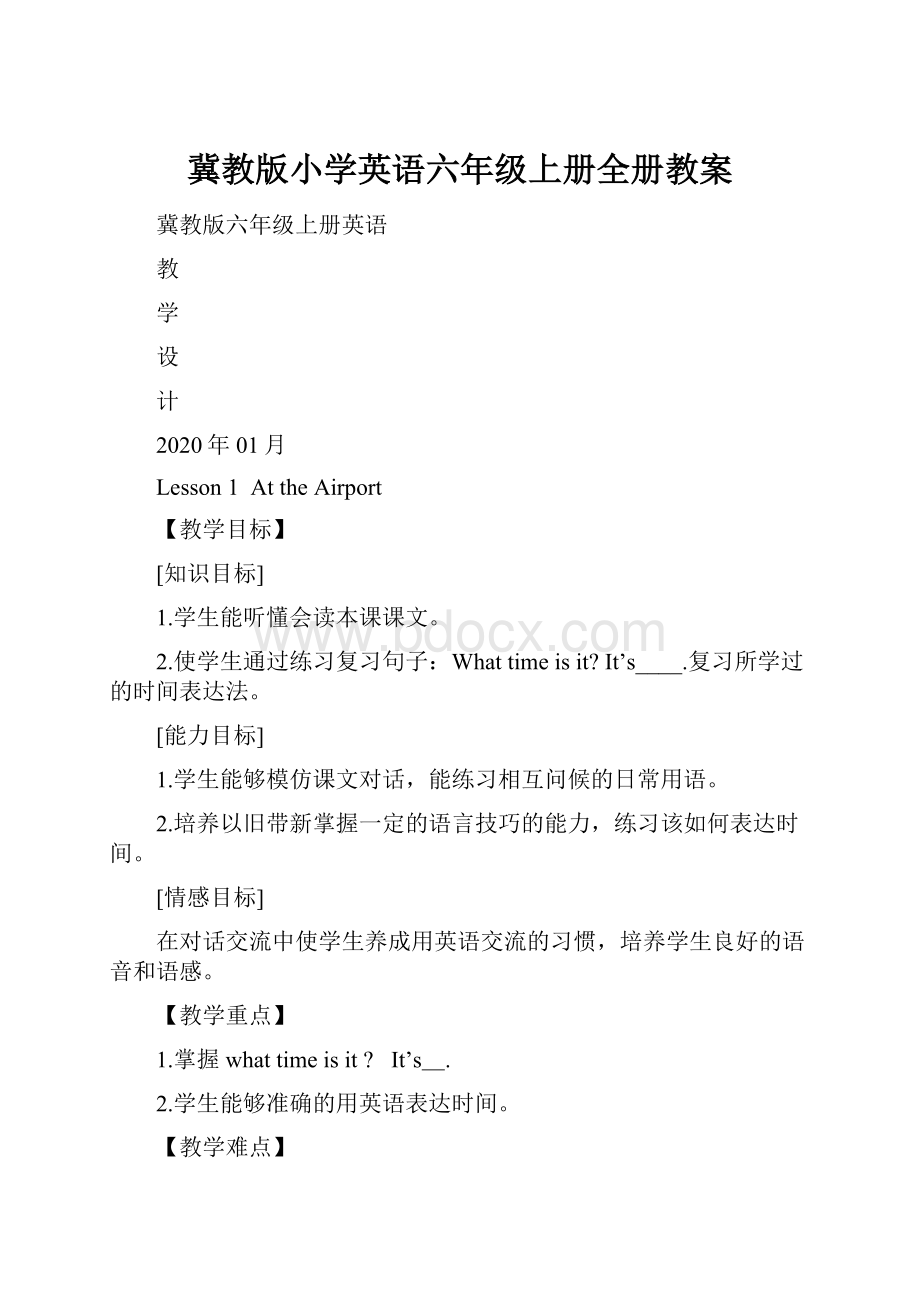冀教版小学英语六年级上册全册教案.docx
《冀教版小学英语六年级上册全册教案.docx》由会员分享,可在线阅读,更多相关《冀教版小学英语六年级上册全册教案.docx(53页珍藏版)》请在冰豆网上搜索。

冀教版小学英语六年级上册全册教案
冀教版六年级上册英语
教
学
设
计
2020年01月
Lesson1 AttheAirport
【教学目标】
[知识目标]
1.学生能听懂会读本课课文。
2.使学生通过练习复习句子:
Whattimeisit?
It’s____.复习所学过的时间表达法。
[能力目标]
1.学生能够模仿课文对话,能练习相互问候的日常用语。
2.培养以旧带新掌握一定的语言技巧的能力,练习该如何表达时间。
[情感目标]
在对话交流中使学生养成用英语交流的习惯,培养学生良好的语音和语感。
【教学重点】
1.掌握whattimeisit?
It’s_.
2.学生能够准确的用英语表达时间。
【教学难点】
能够根据实际情况用英语问答时间。
【教学准备】
时钟、单词卡片
【教学过程】
Step1.Review
1.Playagame:
“Thenumbergame”toreviewnumber。
2.Reviewsomephrases:
Whatdayisit?
Whattimeisit?
Step2.Presentation
1.引出新课题,教授新单词airport,教读数遍并让学生明白单词的意思。
2.Askandanswer:
WhereisLiMing?
WhywillLiMinggotoCanada?
3.Teaching“Whattimeisit?
”
Teacherdrawsaclockontheblackboard.MorethehandsontheclockasTasksandanswerthequestion.
4.Practice:
(1)Practiceinpairs.
(2)Askthevolunteerstomorethehandsontheclockastheyaskandanswerthequestion.
5.Teaching“thetext”.
Step3.Practice
小组合作学习,完成Part3.
Step4.Homework
Makeupadialogueaboutmeetingsomeoneattheairport.
Use“Whattimeisit?
It’s .”
【教学后记】
Lesson2 Jenny’sHouse
【教学目标】
[知识目标]
1.能听、说、读、写单词:
room;kitchen;bathroom;livingroom,掌握Therebe句型。
2.能用英语简单描述自己的家中的各个房间。
[能力目标]
学生能正确运用英语描述家中的房间,能在创设的情境中进行交流,使语言交际与表达能力进一步得到提高。
[情感目标]
在符合实际生活的对话交流中使学生养成用英语交流的习惯,培养学生良好的语音和语感。
【教学重点】
1.能正确运用room;kitchen;bathroom;livingroom,能准确理解课文内容。
2.能正确理解两个形容词性物主代词my,your。
【教学难点】
掌握Therebe句型,并在实际运用中体会Therebe句型的就近原则。
【教学准备】
单词卡片、房间小卡片
【教学过程】
Step1.Greetings
Step2.Revision
Usevocabularycardstoreviewthewords“house”,“classroom”,“bathroom”,“bed”.
Step3.Keyconcepts:
room,kitchen,bathroom,livingroom
1.Introduce:
a.Usepostersofroomstodemonstrateeachword.
b.Pointouttheword“room”inbathroom,bedroomandlivingroom.
c.Freetalk:
Letthestudentsintroducetheirroomsandthethingsinit.
2.Studentbook:
a.Playtheaudiotapeasthestudentsfollowintheirbooks.
My我的.Your你的.
b.Studentssaysentencesfreely,theyshouldholdsomeobjectsintheirhandsorpointtotheobjectsand maketheothersclearabouttheirmeaning.
Step4.Practice
Useapicture-promptdrill.Holdupvocabularycardsforobjectsfoundinparticularroom.
Dividetheclassintosmallgroups.Askeachgrouptomakeupadialogueaboutshowingsomeonearoundanewhouse.
Step5.Homework
Writesomesentencestodescribeyourroomsinyourhouse.
【教学后记】
Lesson3 MakingBreakfast
【教学目标】
[知识目标]
1.使学生争取掌握(正确地说、读、写、用)单词make,breakfast
cook,sink.
2.学生能够理解并且掌握句型:
Whatwouldyoulikeforbreakfast?
Iwouldlikea/an/some____,please.
[能力目标]
使学生能进一步掌握更多有关厨房的名词,扩充词汇量。
[情感目标]
引导学生关注中西方家庭生活的差异,培养学生的跨文化意识。
【教学重点】
能够熟练掌握本课单词和询问早餐吃什么的相关句型。
【教学难点】
理解中西方饮食文化的差异,培养学生的跨文化意识。
【教学准备】
单词卡片、食物卡片
【教学过程】
Step1.ClassopeningandReview
1. Greetings.Say“hello”toeveryone.
2. Review.
Step2.Teach “makeandcook”
Teachthenewwords“breakfast,stoveandsink”.
(1)T:
What’sthis?
(2)T:
Isthiscold?
(Holdupthecardforstove)
(3)T:
Doesasinkhavewater?
(4)Play“Simonsays”topracticethenewwords.
(5)Askthestudentstocometothefronttoread.
Step3.DrillandPractice
1.Studythedialogue
2.Openyourbooks,readthepartoneandanswermyquestion.
WhatwouldJennyandLiMinglikeforbreakfast?
3.Listentotheteacherandfillintheblank.
4.Role-playthedialogue.Dividetheclassintosmallgroups.Askeachgrouptomakeupadialogueaboutmakingamealinakitchen.
Step4.Homework
1.Makeadialogue.
2.writeashortdialogueorpassageaboutamealinakitchen.
【教学后记】
Lesson4 MakingDinner
【教学目标】
[知识目标]
1.掌握单词dinner,kitchen,clean,dirty,dishes,wash,dry。
理解clean,dirty的含义,并会在句子中应用。
2.能够运用“Whatˊs for dinner?
Iˊm cooking…”就就餐话题进行交流。
[能力目标]
让学生能够理解并会书写这些单词及句型,并在情景中熟练运用。
[情感目标]
培养学生热爱劳动,帮助父母做家务的意识。
【教学重点】
学生能够理解并会书写这些单词及句型,并在情景中熟练运用。
【教学难点】
clean和dry的区别与运用,初步理解和使用一般过去时描述过去发生的事情。
【教学准备】
单词卡片
【教学过程】
Step1.ClassOpeningandReview
Greeting.
Review:
Playagame:
“Guessinggame”
Usesomepicturestoreview“kitchen,livingroom,bedroom,bathroom”.Talkabouttherooms.
Step2.Keyconcepts
1.Introduce:
Usetheposteraboutthebathroomtointroduce“bathtub,shower,toilet”.
2.Demonstrate“mine”and“yours”andpractice
(1)T:
(Holdupmypencil)Thisismypencil.
Thisismypencil. It’smine.
Whereisyourpencil?
T:
(Pointtomypencil.)Thisismypencil.Thatisyourpencil.
Thisismine.Thatisyours.
(2)Practiceinpairs.
________is/aremine.
________is/areyours.
3.Teachthetext
(1)Openyourbooks,turntopage8.Listentothe teacher。
(2)Askthestudentstoguessthemeaningof“dirty”and“wash”,Thenexplain。
(3)Askthemtoreadthetextandthenanswerquestions。
Step3.Practice
小组合作学习,完成Part3.
Step4.Homework
Makeanewdialogueaccordingtothetextandactitout.
【教学后记】
Lesson5 InTheLivingRooming
【教学目标】
[知识目标]
1.听、说、读、写客厅里的物品——TV,chair,couch,以及描述或介绍各个房间及房间里的物品的名称、颜色、位置等。
2.掌握人称代词的宾格形式,并将之灵活运用。
[能力目标]
能够牢固掌握现在进行时,并将之灵活运用到课文图片的谈论及实际生活中,就家人在家里的活动用现在进行时进行简单、准确的描述。
[情感目标]
通过学习客厅物品及对家人的描述,教育学生珍惜亲情,热爱家庭,尊重父母。
【教学重点】
1.掌握客厅里的物品单词。
如:
TV,chair,couch.
2.掌握动词短语。
如:
watchTV,readthenewspaper,playcards,writealetter,sitinthechair,sitonthecouch.
【教学难点】
现在进行时的理解、掌握和运用。
【教学准备】
客厅图片、单词卡片
【教学过程】
Step1.Warmingup
A.singasong“Inthelivingroom” B.revision
Step2.Newteaching
T:
Thereisa a and inthebedroom/kitchen/bathroom.Butthere’snothinginthelivingroom.Guess,what‘sinmylivingroom?
(出示电视、小沙发、长沙发图片)
T:
IwanttowatchTV.(指黑板)IsthisaTV?
T:
(课本打开看客厅的图片)Whatcanyoufindinthelivingroom?
Step3.Game
教师让一个学生看动词短语,然后做动作,其他同学回答:
whatishe/shedoing?
whatareyou/theydoing?
what am I doing?
教师把黑板上的短语变成现在进行时的句子。
Step4.Cousolidation
T:
listentotheteacherandanswerthequestion“Is everyoneinthelivingroomquiet?
”
T:
takeoutyourlisteningpaper,listenandfilltheblanks.
Step5.Activities
T:
showapictureofyourlivingroomandtalkaboutitwithyourpartner.
Step6.Homework
Talk aboutyourlivingroomwithyourfriendsandyourfamily.
【教学后记】
Lesson6 BabyBeckyatHome
【教学目标】
[知识目标]
1.能理解故事的大概意思,并准确找出“readandtalk”的相应答案。
2.听说读客厅,厨房的物品——TV,chair,couch,以及描述或介绍各个房间及房间里的物品的名称、颜色、位置等。
3.懂得my和your的意思和用法。
[能力目标]
让学生阅读故事、讲述故事,培养学生大胆表演故事的能力。
[情感目标]
培养学生从小养成爱卫生、爱劳动的好品质。
【教学重点】
学生能够听懂、表演Storytime中的交际内容,能够根据实际情况用英语进行交流。
【教学难点】
正确使用一般现在时。
【教学准备】
课文录音、钟表、单词卡片
【教学过程】
Step1.GreetingandReview.
Step2.Cometothe “StoryTime”
PlaytheVidioofthestory,andaskthestudentstocirclethewordsaboutlivingroomandkitchen.
Step3.Cometo “Readandtalk”
Askthestudentstoreadthestorybythemselves,thentalkwithpartersandfinishthequestions.
Step4.Learningthestory
Groupwork:
trytotranslatethestory intoChineseandknowaboutthemeaningofthetest.
Thenteachercheckthestudy.
Reviewthewords“my”and“your”.
Step5.Dotheexercisebook,andfillintheblacks.
Step6.Homework
Learnthewordsofthisunitbyheart.
【教学后记】
Again,Please!
【教学目标】
[知识目标]
1.听说读客厅、厨房的物品——TV,chair,couch以及描述或介绍各个房间及房间里的物品的名称、颜色、位置等。
2.懂得mine和yours的意思和用法。
[能力目标]
通过师生互动、生生互动培养学生的听说及综合语言运用能力。
[情感目标]
让学生了解西方国家的学校教育、民族风情以及饮食文化,对比中西方之间的差异。
【教学重点】
掌握本课重点单词和句子。
【教学难点】
1.理解掌握mine,和yours的意思和用法。
2.能灵活运用Whattimeisit?
It’s…句型问答时间。
【教学准备】
课文录音、单词卡片
【教学过程】
Step1.Greetingeachother.
Step2.Reviewthewordsofthisunit,thenhaveadictationthewordsandcheckeachother.
Step3.Cometo “Listen.Tickorcross”
Letthestudentslookatthepictures,thenplaythelistening,anddotheListening“tickorcross”
Cometo“Listen,matchandwrite”
Letthestudentslookatthepictures,thenplaythelistening.
Afterlistening,askstudentstomatchandwrite.
Thenchecktogether.
Step4.Cometo “Listeningandcircle ”
Playthe listening,whiledothelisteningexercise.
Thenchecktheanswerstogether.
Step5.Cometo “Lookandwrite”
Askthestudentstodotheexercise“Lookandwrite”bythemselves,thenasksomeonetoreadthequestions,andcheck“rightorwrong”together.
Step6.Homework
Reviewthenotebookofthisunit.
【教学后记】
Again,Please!
【教学目标】
[知识目标]
1.听说读客厅,厨房的物品——TV,chair,couch以及描述或介绍各个房间及房间里的物品的名称、颜色、位置等。
2.能通过阅读短文,明白文章大意、回答问题并体会文章背后蕴含的情感。
[能力目标]
通过师生互动、生生互动培养学生的听说及综合语言运用能力。
[情感目标]
让学生了解西方国家的学校教育、民族风情以及饮食文化,对比中西方之间的差异。
【教学重点】掌握本课重点单词和句子。
【教学难点】
1.理解掌握mine,和yours的意思和用法。
2.能灵活运用人称代词的宾格形式。
【教学准备】课文录音、单词卡片
【教学过程】
Step1.Greeting
1.Greetingeachother.
2.Reviewthewords:
him,her,them,you,me,us.
3.Reivewthewords:
mine,yours.
Step2.Fillintheblacks
1.Fillintheblacksof“ReadandWrite”
2.Asksomeonetodothequestionsinfrontoftheclass,andtheotherscheckrightorwrong.
Ifwrong,theothersdotheexercisetogether.
Step3.Cometo “Read,drawandorder”
Reviewhowtoexpressthetime,andgivesomeexamples.
Dotheexercisefirst,thendotheexercisetogether.
Step4.Cometo “readandmatch”
Readthetext,thenmatchtherightpictures,andcheckwithsmallgroups.
Step5.Cometo “Lookandsay”
Groupwork:
Askandanswer:
Wherearethey?
Whataretheydoing?
Step6.Homework
Learnthewordsoftheunitbyheart.
【教学后记】
Lesson7 OntheSchoolBus
【教学目标】
[知识目标]
1.学习并掌握always,sometimes,often,never等表示频度的词汇。
2.掌握四会词汇:
dry/wet,umbrella,driver.
[能力目标]
学生能用所学词汇、句型谈论日常生活的一些话题。
[情感目标]
培养学生健康有效的生活理念,激发和培养学生学习英语的欲望。
【教学重点】
掌握用一般现在时(主语三单和非三单)和goto…by…,walkto…,ride…bike等表达日常生活中的出行方式。
【教学难点】
频度副词:
always often sometimes never的理解和运用。
【教学准备】
课文录音、单词卡片
【教学过程】
Step1.Greeting
Step2.Review
出示卡片复习常用短语:
have breakfast,watch TV,gotothepark,gotoschool,bybus…
Step3.KeyConcepts
1.Always/usually/sometimes/never的教学。
教师利用Danny/Jenny/Steven/ LiMing一周吃早餐的图表学习单词。
Healwayseats donutsforbreakfast.(教师放慢速度,并强调always)
2.单词的理解和运用。
(由于这四个表示频度的副词对学生来说比较抽象